
Assumption is a c. 1623 oil-on-canvas painting of the Assumption of Mary by the Italian artist Guercino, now in the Hermitage Museum in Saint Petersburg.

Assumption is a c. 1623 oil-on-canvas painting of the Assumption of Mary by the Italian artist Guercino, now in the Hermitage Museum in Saint Petersburg.
Its style is similar to that of the same artist's The Burial of St. Petronilla , [1] the apostles are similarly shown to those in Guido Reni's 1617 Assumption (church of Sant'Ambrogio in Genoa) and one of the figures is identical to Guercino's Saint Matthew (Dresden). An early copy of the figure of John the Evangelist (in the foreground in a red cloak) survives in the Doria Pamphilj Gallery in Rome and for a time was considered as an oil sketch for the work by Guercino himself, whilst another early copy of that figure was auctioned on 25 October 1985 at Christie's in London. [2]
Commissioned by count Alessandro Tanari, it remained in his family for over 200 years. In 1841 it was acquired for the Hermitage by order of Tsar Nicholas I via Pavel Krivtsov, first secretary to the Russian Imperial embassy in Rome, with Gaetano Giordani regretting that Italy had thus lost "such a significant work by the famous artist". [3] It arrived in Saint Petersburg the following year, although an 1840 copy made before it left is now in the Pinacoteca at the Vatican.

Agostino Carracci was an Italian painter, printmaker, tapestry designer, and art teacher. He was, together with his brother, Annibale Carracci, and cousin, Ludovico Carracci, one of the founders of the Accademia degli Incamminati in Bologna. Intended to devise alternatives to the Mannerist style favored in the preceding decades, this teaching academy helped propel painters of the School of Bologna to prominence.
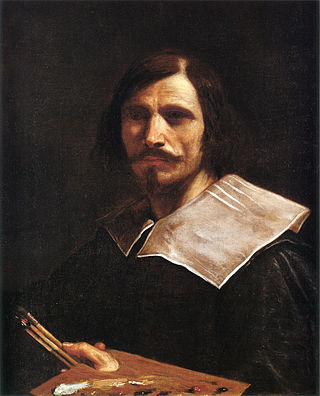
Giovanni Francesco Barbieri, better known as (il) Guercino, was an Italian Baroque painter and draftsman from Cento in the Emilia region, who was active in Rome and Bologna. The vigorous naturalism of his early manner contrasts with the classical equilibrium of his later works. His many drawings are noted for their luminosity and lively style.

Annibale Carracci was an Italian painter and instructor, active in Bologna and later in Rome. Along with his brother and cousin, Annibale was one of the progenitors, if not founders of a leading strand of the Baroque style, borrowing from styles from both north and south of their native city, and aspiring for a return to classical monumentality, but adding a more vital dynamism. Painters working under Annibale at the gallery of the Palazzo Farnese would be highly influential in Roman painting for decades.
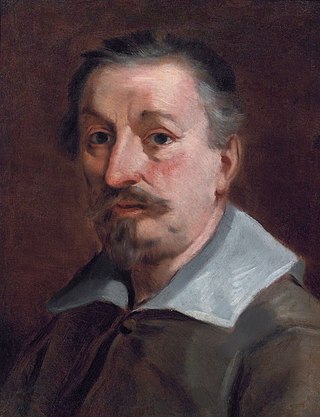
Francesco Albani or Albano was an Italian Baroque painter of Albanian origin who was active in Bologna, Rome, Viterbo (1609–1610), Mantua (1621–1622) and Florence (1633).

Karl Pavlovich Bryullov, also Briullov or Briuloff, born Charles Bruleau was a Russian painter. He is regarded as a key figure in transition from the Russian neoclassicism to romanticism.

The Lute Player is a composition by the Italian Baroque master Caravaggio. It used to exist in two versions, one in the Wildenstein Collection and another in the Hermitage Museum, St. Petersburg. A third version, which was kept for 275 years at Badminton House, Gloucestershire, came to light in 2001, and which today is understood to be the original version. The Hermitage and the Badminton House versions were exhibited together in 2020 at the Galleria Borghese.

Fyodor (Fidelio) Antonovich Bruni was a Russian artist of Swiss Italian descent who worked in the Academic style.

Carlo Cesare Malvasia (1616–1693) was an Italian scholar and art historian from Bologna, best known for his biographies of Baroque artists titled Felsina pittrice, published in 1678. Together with his contemporary Giovanni Pietro Bellori, Malvasia is considered "among the best informed and most intelligent historians and critics of art who ever lived."

Bartolomeo Cavarozzi (1587–1625), occasionally referred to as Bartolomeo Crescenzi, was an Italian caravaggisti painter of the Baroque period. Cavarozzi's work began receiving increased admiration and appreciation from art historians in the last few decades of the 20th century, emerging as one of the more distinct and original followers of Caravaggio. He received training from Giovanni Battista Crescenzi in Rome and later traveled to Spain alongside his master for a few years where he achieved some renown and was significant in spreading "Caravaggism" to Spain before returning to Italy. His surviving works are predominantly Biblical subjects and still-life paintings, although older references note he "was esteemed a good painter especially of portraits".

Matthew Afanasyevich Chizhov (1838–1916) was a Russian sculptor.

Descent from the Cross is an oil-on-canvas painting of 1600–1602 by the Flemish artist Peter Paul Rubens. It was his first major commissioned work made for the private chapel of Eleonora de’ Medici Gonzaga (1567–1611), duchess of Mantua. The painting remained somewhat obscure until 2001, when it was discovered by German art historian Justus Müller-Hofstede, a specialist on Rubens' early work.
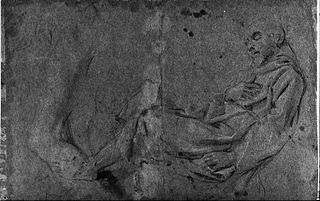
The Death of Saint Francis is the probable subject of two lost paintings by Annibale Carracci, both possibly dating to 1597-1598. One is known solely through a print and the other through a series of painted copies.
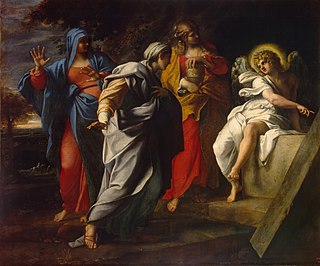
The Three Marys at the Tomb, The Three Marys or The Pious Women at Christ's Tomb is a 1598 oil on canvas painting by Annibale Carracci, now in the Hermitage Museum in Saint Petersburg, which acquired it in 1836.

Pietà with Saint Francis and Saint Mary Magdalene is a 1602-1607 oil on canvas painting by Annibale Carraci. Now in the Louvre, it was looted from the Mattei family chapel in San Francesco a Ripa in Rome by Napoleon's troops in 1797 and was not returned at the end of the Napoleonic Wars.

Self-Portrait on an Easel is a 1603-1604 oil on panel painting by Annibale Carracci, now displayed in Room 231 of the New Hermitage Building of the Hermitage Museum in Saint Petersburg. The portrait from the work was repeated for an autograph self-portrait now in the Uffizi, whilst a 1595 version of the Hermitage work is also in the Uffizi.
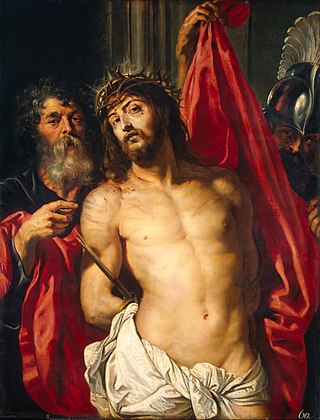
Ecce Homo or Christ Wearing the Crown of Thorns is an oil on oak panel painting of the Ecce Homo subject by Peter Paul Rubens, executed c. 1612, now in the Hermitage Museum, in Saint Petersburg. The Hermitage also houses an oil study for its figure of Pilate.

Portrait of Pope Paul III with Camauro is a 1545 – 1546 oil on canvas painting by Titian, now in the Museo nazionale di Capodimonte in Naples.

Saint Matthew and the Angel is a 1621–1622 oil-on-canvas painting, produced by the Italian Baroque artist Guercino during his early years in Rome and now in the Musei Capitolini in Rome.

The Death of Dido is a 1631 oil-on-canvas painting by the Italian Baroque painter Guercino, commissioned by Cardinal Bernardino Spada for Maria de' Medici. It now hangs in the Galleria Spada in Rome.

The Martyrdom of Saint Catherine is a 1653 oil on canvas painting by Guercino, commissioned by Cento to present to cardinal Alderano Cibo, papal legate in Ferrara.